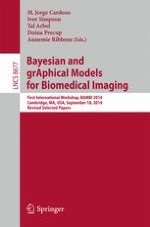This book constitutes the refereed proceedings of the First International Workshop on Bayesian and grAphical Models for Biomedical Imaging, BAMBI 2014, held in Cambridge, MA, USA, in September 2014 as a satellite event of the 17th International Conference on Medical Image Computing and Computer Assisted Intervention, MICCAI 2014.
The 11 revised full papers presented were carefully reviewed and selected from numerous submissions with a key aspect on probabilistic modeling applied to medical image analysis. The objectives of this workshop compared to other workshops, e.g. machine learning in medical imaging, have a stronger mathematical focus on the foundations of probabilistic modeling and inference. The papers highlight the potential of using Bayesian or random field graphical models for advancing scientific research in biomedical image analysis or for the advancement of modeling and analysis of medical imaging data.
